There are many different kinds of wires that one will find throughout a home. While it is best to leave most electrical projects to a professionally trained and licensed electrician, you will likely encounter and interact with wires at some point. Any household electrical wire can be dangerous if used without proper knowledge and caution. In this article, we will discuss the most common types of wire you will find in your house so that you can safely navigate wiring and keep your home and family safe.

Types of Household Electrical Wire You Should Know About
What Comprises a Wire?
The term “wire” may conjure a few different pictures in your head. Household wires are usually actually bundles of wires wrapped together in an insulated sheath to keep them together and protected. The wires themselves are made from copper, aluminum, or copper-sheathed aluminum. Each individual wire in the bundle has a specific function for which it should be color-coded.
Nonmetallic Cable
This is the type of wire you encounter most often in a house. Nonmetallic, or NM, cable always contains a hot, neutral, and ground wire. There may be more than one hot wire present in the cable, depending on its intended use. All of your outlets and light switches are likely powered by NM cables running behind your walls from the control panel to every fixture in your house. The size of the cable will depend on the circuit’s amperage–14 gauge wires can handle a maximum of 15 amps, while a six gauge wire can conduct up to 55 amps. Remember to never go near NM cable when the hot wire may be live, as the shock you get from touching it can be quite detrimental.
Underground Feeder Cable
Feeder cables have extra insulating protection–all of the wires are wrapped individually, then wrapped again in an outer sheathing to hold them all together. UF cables are nonmetallic, but they are considered separate from standard NM cables because they are meant to be buried directly in the ground to power outdoor items such as pumps, lamps, and sheds. These wires carry more electricity than those in an indoor outlet box, so be extra cautious when handling them. Take note of where the lines are buried so that you do not accidentally hit or cut them while doing yard work later on.
THHN/THWN Cable
In some cases, THHN (Thermoplastic, Highly Heat-Resistant, Nylon-Coated) or THWN (Thermoplastic, Heat-Resistant, Wet Location, Nylon-Coated) cables are used in a home. They do not have bundles of individually-wrapped wires the way NM cables do; instead, each THHN/THWN cable is a single conductor with just one function. The metal or plastic that insulates them is quite durable because these wires are used when you need to run power through an exposed area. You often see these wires in unfinished basements or garages. The thicker sheath protects the wires from exposure to water, heat, and other elements that would harm a standard wire.
Low Voltage Wire
Low-voltage wires are used for small landscaping electric systems, doorbells, or other projects with minor electrical needs. The wires are usually very thin and may be wrapped individually in insulation or twisted together with insulation covering the whole twist. Be sure to use low-voltage wires for circuits less than 50 volts; anything more will overload the wires and cause issues.
Unless you are familiar with electrical wiring, experts do not recommend that you attempt any home electrical projects. Promise Electric offers residential services to Sarasota homeowners – and we are happy to come out to help you with your electrical needs.


